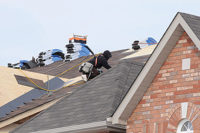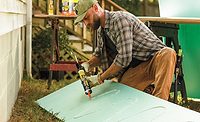Construction Tape Trends
New acrylic construction tapes outperform traditional rubber and asphaltic options.




Ten years ago, a variety of adhesive construction tapes was available. The choices were limited to rubber, butyl and asphaltic tape, each offering known pros and cons to builders. As higher-performance tapes, including improved rubber, butyl and newer acrylic tapes, entered the construction marketplace, builders were flooded with a widening variety of options. The number of tapes available today is overwhelming; however, choosing the right one could make a huge difference in a project’s integrity, longevity and energy efficiency.
As customers demand more energy-efficient homes and building energy codes become stricter, it’s essential for builders to know the differences between tapes’ performance level over time, longevity in weather extremes, watertight and airtight features, and more. Today’s newer and higher-performing acrylic adhesive tapes offer builders better choices and multiple advantages over previous choices. These tapes actually stick better over time, are more durable, are more weather resistant, are easier to apply and are more environmentally sensitive, producing minimal fumes and off-gases than the less-effective rubber, butyl, and asphaltic tapes of the past.
It seems logical that the building and construction industries would quickly adopt the use of more effective and better-quality adhesive tapes. While many builders and architects in the U.S. have begun using acrylic tapes due to their many advantages, the country is far behind the European building trades in embracing and using the latest acrylic tapes. In fact, tape experts cite Europe as the best example of overall utilization of acrylic tapes in construction.
“In Europe, they tape up everything when building or retrofitting to create an air-tight seal,” says David Joyce, nationally known construction and tape expert (and self-proclaimed “tape geek”), and owner of Synergy Companies Construction LLC. “Energy costs are much higher there, and it’s a matter of necessity.” Joyce notes that the industry here in the U.S. “is just recently becoming more aware of the benefits of air-tight building practices and that acrylic tapes make that much easier.”
Part of the reason for the delay in the adoption of higher-efficiency tapes could be that there are so many to choose from. Builders have myriad details to consider during construction; selecting what tape to use might not be at the top of the list. Builders and construction industry workers tend to use familiar products that have worked in the past, rather than take a chance on something new. When a project is on a tight financial budget and needs to be completed in a short timeframe, taking a chance on a new tape that some salesperson or website says is the “best” could be the last thing on a builder’s mind.
Joyce agrees that there might be some instances when both a rubber tape and an acrylic tape can be used synergistically. In order to understand the advances in the construction industry tape marketplace, it’s essential to look back at how tapes have progressed, most notably in the last 10 years.
Early Construction Tapes
Asphaltic tapes continue to be the most widely used tapes in the construction industry due to their low cost. But they traditionally had many problems, including being messy, off-gassing environmentally harmful volatile organic compounds (VOCs), produced with petroleum, loss of adhesion in either very high or very low temperatures, susceptibility to degradation, potential for brittleness in very cold weather, and loss of durability due to UV exposure. This type of tape also had questionable adhesion properties, depending on the surfaces being joined or sealed. However, asphaltic tape is the least expensive when compared to rubber or acrylic tapes, and is the most widely available.
As builders and remodelers have discovered past building practices when retrofitting older buildings or adding onto existing structures, they have noted the poor track record of this type of tape over a period of many years. With more contractors trying to reach air sealing levels that can be measured with blower tests, the type of tapes being used is becoming more important.
Rubber and Butyl Adhesive Tapes
Still in use today, these tapes were designed as an “upgrade” to asphaltic tapes. Originally used with natural rubber components, most “rubber” tapes today use a type of synthetic rubber or elastomer, and are sometimes referred to interchangeably as butyl tapes. Many builders use these tapes for flashing around windows and doors, for roofing, and for other similar applications.
These tapes were a suitable replacement for asphaltic tapes for most uses in home construction. Improvements included better performance in both temperature extremes, retention of flexibility, and better durability over time than asphaltic tapes. In addition, they are less expensive than acrylic tapes. These tapes perform better than asphaltic tapes, but still have lower temperature tolerances than acrylic tape, emit VOCs, lose adhesion over time, will eventually discolor, and have a weak UV tolerance. In addition, they should only be used indoors.
Acrylic Adhesive Tapes
Acrylic tapes have been around for a while as well, but as air sealing requirements increase so does the need for tapes that perform best. The newer evolutions of this kind of tape are used in applications other than home construction, including the marine and aviation industries, with great success. As with other tapes, there are many kinds of acrylic tapes, but all perform far better than the other types of construction tapes. Acrylic tapes are superior because they offer long-term durability, are “greener” tapes that do not off-gas or pollute landfills, offer adhesion properties that actually become stronger over time rather than weaker, can withstand temperature extremes without any loss of adhesion or performance, can be used indoors and outdoors, and have a high UV tolerance. The only real downside is the cost; these tapes cost a bit more than the rubber or asphaltic tapes.
Builders often use these tapes to completely seal a home, creating an airtight envelope. If the ultimate objective is to reduce energy costs by building an air-tight structure, acrylic tapes are high performers that adapt to any surface and any temperature while providing a completely sealed home, if used correctly. Any tape can under-perform if not applied in the correct manner. In addition, creating a weather- and air-tight home depends on many factors. Joyce uses acrylic tapes in every home he constructs or remodels. “I tape every seam on a building, mostly with acrylic tapes,” he says.
“Tapes have become much more commonplace in the construction industry today than they were 10 years ago,” Joyce says. “And they’re going to become more and more so as air sealing, energy efficiency and durability become more important, and builders are becoming more educated about the benefits of tapes over other sealants or flashing materials.”
While there have been conversations about whether an air-tight house is better than one with a little outside air coming in through spaces like a basement or around windows, it’s important to remember that the “natural” air coming into your house is probably coming through an area that is dirty, or harbors mold or mildew. Joyce says that an air-tight home is not only a more durable home, it’s a more hygienic one.
In addition, taping every inside and outside seam creates a more durable home. If water, mold and mildew infiltrate the barriers through weaknesses in the home’s seals, either through ineffective flashing or improper sealing, it can lessen the lifetime of the home—not to mention increasing costs for heating and cooling. “In hot and humid climates, when air leaks into walls, it can deposit water when it hits a cold condensing surface,” says Matt Risinger, nationally recognized blogger and owner of Risinger Homes in Austin. “This creates a perfect mold environment. Air-sealing is one of the best ways to combat that process and protect a home.”
It may take a while for builders to make the switch to acrylic tapes for all flashing and sealing, but, as building energy codes change, better efficiencies will be mandated and the building industry will have to comply. According to an article in Architectural Record, the International Residential Code (IRC) includes an International Energy Conservation Code requirement of an air barrier to prevent air leakage through the building envelope (IECC Section 402.4).1 In 2009, the regulations required seven air changes per hour (ACH) and, in 2012, that regulation decreased the number of air exchanges to three to five per hour, depending on the climate zone.
As the energy efficiency of a home increases, the ACH decreases, meaning the home is more airtight, thus uses less energy. While this might sound odd, remember that being airtight isn’t a bad thing; in fact, because you control the quality of the newer, energy-efficient heating and cooling systems and you maintain your home’s filtration system and air quality, your home’s interior environment will be cleaner.
Embracing Improvements
When it comes to choosing the best construction tape, the maxim that “if it ain’t broke, don’t fix it” simply won’t cut it. High-performance construction tapes will become more important as the construction industry deals with stricter regulations and as best practices in the industry change with the times.
Builders and contractors can save time and create a more efficient and durable home with acrylic tapes. In fact, the tapes might just impress a remodeler 10-20 years from now, when he or she dismantles the walls you built and marvels at the condition of the walls and the durability of the tape used to seal the home.
For more information, contact the author at risae@echotape.com or visit www.echotape.com.
Looking for a reprint of this article?
From high-res PDFs to custom plaques, order your copy today!







